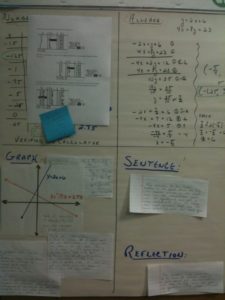I recently had a conversation about formative assessment with two algebra II teachers. It was a great conversation about creating opportunities for students to make products to show what they know, how teachers can use these products to learn more about the thinking of their students, and how to intentionally integrate these kinds of products routinely into instruction. One reason the conversation was so strong is because we started off talking about what we wanted to know about what the students were learning and moved to what that might look like, before we ever discussed strategy or instruction. It gave us several ideas to pursue. The conversation wasn’t about what we were or weren’t doing but about how we can tell what the students know and use that to help us inform what happens next in the classroom. Wiliam and Black (1998) identified five simple factors for effective formative assessment:
- immediate, effective feedback to students
- involvement of students in their own learning
- adjust instruction based on results of assessment
- student self assessment and understand how to improve performance
- recognize influence assessment has on the motivation and self esteem of students
The result of the conversation was a matrix that looked at the learning cycle (access prior knowledge, during learning, synthesis/summary) along one dimension and process, algorithm/computation, and multiple representation/communication along the other. We then proceeded to identify different strategies, products, and uses for each category. It was interesting to look at different aspects of the learning cycle and then think about how we create opportunities to have students show what they know during that cycle with the express purpose of having students give and get feedback that is timely and influences next instructional steps. One strategy identified by one of the teachers stood out for me. She had different rows of students solve a problem using specific methods (i.e. row 1 solved the linear system using graphing, row 2 solved the same problem using substitution, and row 3 solved the problem using linear combination). She then had students from the different rows come together to explain how they solved the problem, compare answers, and compare processes. At the end of the activity she had group products that solved each problem in multiple ways, had an explanation of what the solution meant from the different perspectives, and to my great joy, an analysis of the strengths and weaknesses of each method for solving that particular problem. She built into the conversation a quick student reflection on what they learned about the characteristics of the problem that made a particular method most effective, and which method made most sense to the student. I almost stopped our conversation right here, because for me that was it. Students were involved in the process, were able to talk about the strengths of a particular method, the teacher is able to use what she heard during the conversations to clear up any misconceptions and point to any insights, and post the products for extended conversations/models. I think it’s very important to have students communicate what they know, but without a responsive teacher being willing and able to use that information to make their instruction more responsive then deeper learning may not be able to occur. This teacher gets it, she understands the need for extended conversation, organization of ideas, developing group understanding, providing immediate feedback, and making students responsible for their learning.
Picture: “linear system multiple representation” by rodaniel,
http://www.flickr.com/photos/rlodan01/ / CC BY-NC-ND 2.0
Black, P., & Wiliam, D. (1998). Assessment and classroom learning. Assessment in Education, 5 (1), 7–74.

